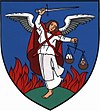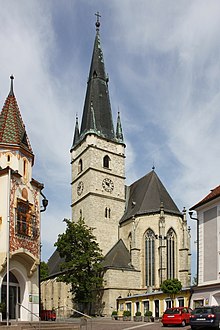Haag (Lower Austria)
|
Borough Hague
|
||
|---|---|---|
| coat of arms | Austria map | |
|
|
||
| Basic data | ||
| Country: | Austria | |
| State : | Lower Austria | |
| Political District : | Amstetten | |
| License plate : | AT THE | |
| Surface: | 54.97 km² | |
| Coordinates : | 48 ° 7 ' N , 14 ° 34' E | |
| Height : | 346 m above sea level A. | |
| Residents : | 5,639 (Jan 1, 2020) | |
| Postal code : | 3350 | |
| Area code : | 07434 | |
| Community code : | 3 05 14 | |
| NUTS region | AT121 | |
| Address of the municipal administration: |
Hauptplatz 4 3350 Hague |
|
| Website: | ||
| politics | ||
| Mayor : | Lukas Michlmayr ( ÖVP ) | |
|
Municipal Council : (Election year: 2020 ) (29 members) |
||
| Location of Haag in the Amstetten district | ||
 town hall |
||
| Source: Municipal data from Statistics Austria | ||
Haag is a municipality with 5,639 inhabitants (as of January 1, 2020) in the Amstetten district in Lower Austria .
geography
Haag is located in the west of the Mostviertel in the Lower Austrian Alpine foothills , around 16 percent of the community area is forested.
Community structure
Haag consists of twelve cadastral communities (area: as of December 31, 2017). The towns of the same name were dissolved in 2020:
- Edelhof (622.97 ha) including Ederhöhe, Fadlhof, Pesendorf, Sieberg and Untermayrhofen
- Gstetten (312.96 ha) including Klingenbrunn, Paga and Ziegelstadl
- Haag Stadt (273.40 ha), the village of Haag including Himsental
- Heimberg (360.94 hectares) including Ausermayrhofen, Imberg and town halls
- Holzleiten (450.31 ha) including Göblitz, Hadersbach, Hochwall, Unreinfußen, Winnersdorf and Zauchhof
- Knillhof (399.41 ha) including Pernersdorf, Pinnersdorf and Stampfhof
- Krottendorf (480.32 ha) including fiefs, ripples, forest farmers, forest houses and Wolflucken
- Porstenberg (296.93 ha) including Mitterndorf and Richersdorf
- Radhof (519.66 ha) including Dörfl, Hub, Spitzenwinkel and Stibitzhof
- Reichhub (779.45 ha) including Ederhöhe, Klaubling, Lembach and Radelsbach
- Salaberg (371.81 ha) including forest houses
- Schudutz (627.73 ha) including Braunsberg, Haindorf, Kroisboden, Schmiedhub and Tiefenleiten
Neighboring communities
history
In ancient times the area was part of the Roman province of Noricum .
- In 1032 the consecration of the church in Haag was documented by the Passau bishop Berengar, this is the first documented mention of the place name.
- Salaberg Castle was first mentioned in a document in 1282.
- In 1921 the municipality of Haag was divided into the municipality of Haag-Land and Markt Haag.
- In 1932 Markt Haag was elevated to the status of town.
- In 1938 the separate municipalities Stadt Haag and Haag-Land were merged into one larger municipality.
coat of arms
In 1563, Emperor Ferdinand I gave the then Markt Haag the coat of arms with the image of the Archangel Michael.
Population development

politics
The municipal council has 29 members.
- With the municipal council elections in Lower Austria in 1990, the municipal council had the following distribution: 15 ÖVP, 7 SPÖ, 6 list for Haag and 1 FPÖ.
- With the municipal council elections in Lower Austria in 1995, the municipal council had the following distribution: 14 ÖVP, 8 list for Haag, 6 SPÖ and 1 FPÖ.
- With the municipal council elections in Lower Austria in 2000, the municipal council had the following distribution: 17 ÖVP, 6 list for Haag, 5 SPÖ and 1 FPÖ.
- With the municipal council elections in Lower Austria in 2005 , the municipal council had the following distribution: 17 ÖVP, 8 SPÖ and 4 list for Haag.
- With the municipal elections in Lower Austria in 2010 , the municipal council had the following distribution: 16 ÖVP, 8 SPÖ, 4 list for Haag and 1 FPÖ.
- With the municipal council elections in Lower Austria in 2015 , the municipal council had the following distribution: 16 ÖVP, 6 list for Haag, 6 SPÖ and 1 FPÖ.
- With the municipal council elections in Lower Austria 2020 , the municipal council has the following distribution: 17 ÖVP, 9 list for Haag and 3 SPÖ.
mayor
- until 2015 Josef Sturm (ÖVP)
- since 2015 Lukas Michlmayr (ÖVP)
Culture and sights
- Catholic parish church Hague hl. Michael: In Haag there is a late Gothic fortified church, built between 1432 and 1485 , which is dedicated to St. Michael. In 1969/70 the interior was completely redesigned, and in 2001 a new organ with 36 registers was inaugurated ( Orgelbau Kögler , St. Florian).
- Salaberg Palace : with components from the Renaissance and the Baroque . Not open to the public. The Venetian ballroom can, however, be rented for events and the palace chapel is also available for church celebrations.
- Supply House Chapel Haag
- Baroque bath house: The baroque bath house belonging to Salaberg Palace can be visited.
- Lower Austrian Open-Air Museum: presents around 20 objects (old buildings), mainly from the Mostviertel.
- Mostviertel Museum: The Mostviertel Museum shows countless objects on the subject of cider, field farming, flax processing, beekeeping, old living culture, etc. a.
- Zoo Stadt Haag : with more than 80 domestic and exotic animal species. Open year-round zoo located in the park Castle Salaberg of Eduard Petzold .
- Hague theater cellar
- Parkbad Haag
Regular events
- Theater Summer Haag : Artistic Director Christian Dolezal ; The Hague Theater Summer has been held annually since 2000; It is played on the main square on the temporary theater stand, which has received multiple awards.
economy
In 2001 there were 214 non-agricultural workplaces, and according to the 1999 survey there were 242 agricultural and forestry businesses. According to the 2001 census, the number of people in employment at home was 2,325. The employment rate in 2001 was 47 percent. In 2003 there were 372 unemployed people on average.
traffic
- Railway: The city of Haag is located on the old route of the Western Railway , which has a stop here. (The new line travels around the city in the 6840 m-long Siebergtunnel .) Near the junction Haag is the West Highway A 1; a few kilometers further is in Strengberg the Wienerstraße reach B1. This means that the district capital Amstetten , the provincial capital Sankt Pölten and finally Vienna as well as the cities of Enns and Linz, which are already in Upper Austria , are easily accessible.
- Road: There is a connection to Steyr about 15 km away via Haager Straße B 42 .
Personalities
- Hans Achatz (1943–2017), politician and judge
- Wolfgang Brandstetter (* 1957), Vice Chancellor and Minister of Justice
- Franz Brunner (1926–1982), farmer and politician
- Josef Leeb (1921–2005), conductor
- Jessica Pilz (* 1996) sports climber
- Wilhelm Ripl (* 1937), limnologist
- Armin Sturmberger (1891–1973), architect
Web links
- 30514 - Hague. Community data, Statistics Austria .
- Web presence of the municipality of Haag
Individual evidence
- ↑ Regionalinformation.zip (Excel file, 1,210 kB); accessed on January 4, 2018
- ^ Haus-Chroniken von Haag: Division of the community Haag
- ^ House chronicles of Haag: Land-Haag incorporated into the city of Haag.
- ↑ Further historical details - such as the entries from the handwritten land register - are available at chronik.stadthaag.com
- ^ Result of the local council election 1995 in Haag. Office of the Lower Austrian State Government, March 30, 2000, accessed October 17, 2019 .
- ^ Election result of the municipal council election 2000 in Haag. Office of the Lower Austrian State Government, February 4, 2005, accessed on October 17, 2019 .
- ^ Election result of the local council election 2005 in Haag. Office of the Lower Austrian State Government, March 4, 2005, accessed on October 17, 2019 .
- ^ Election result of the local council election 2010 in Haag. Office of the Lower Austrian State Government, October 8, 2010, accessed on October 17, 2019 .
- ^ Election results for the 2015 municipal council elections in Haag. Office of the Lower Austrian State Government, December 1, 2015, accessed on October 17, 2019 .
- ↑ Results of the local council election 2020 in Haag. Office of the Lower Austrian State Government, January 26, 2020, accessed on February 17, 2020 .
- ↑ Mostviertel Museum









